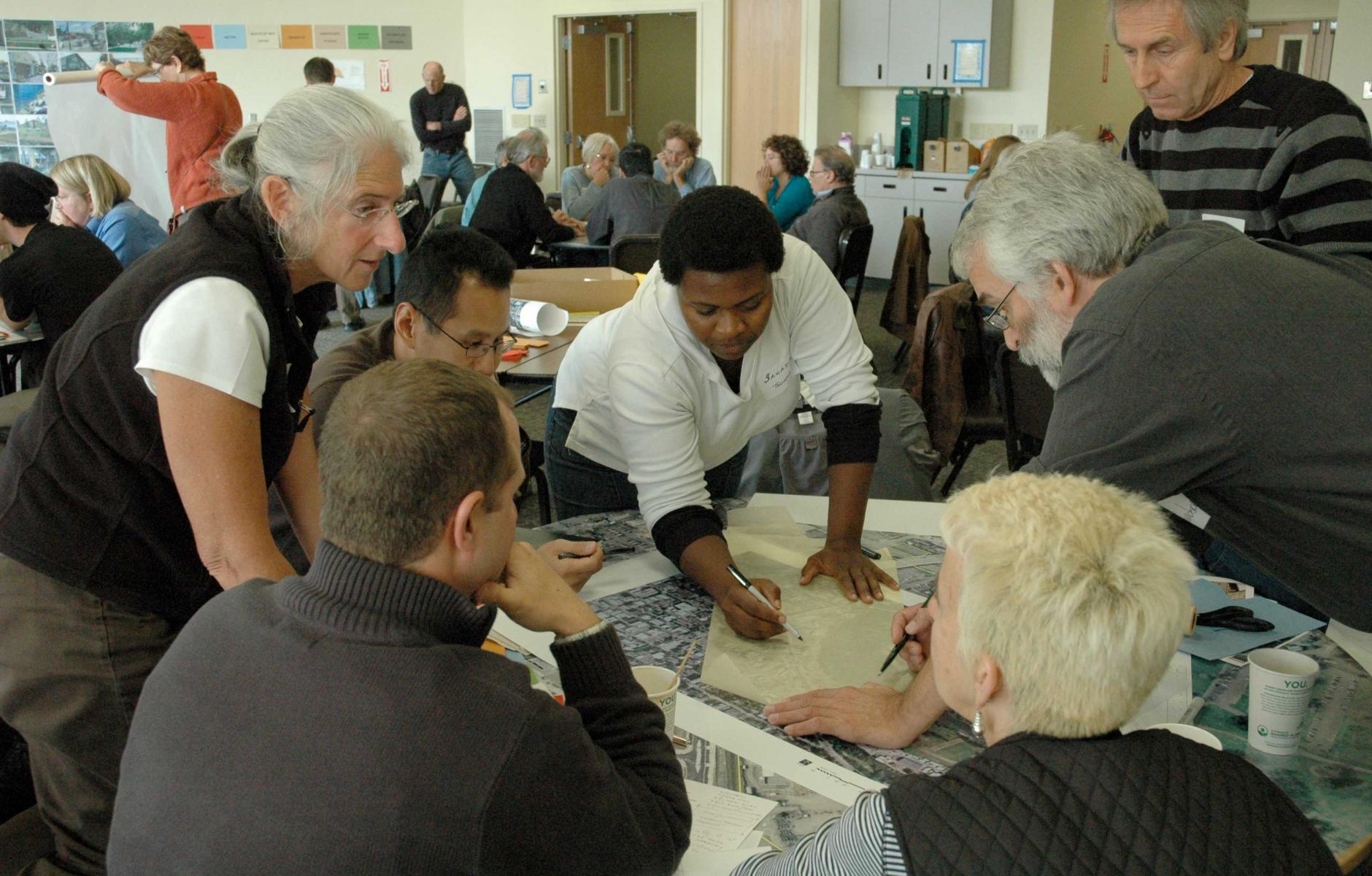
How to run a Lean charrette
Note: This article was written as part of the Project for Lean Urbanism and edited for Public Square.
Over the past decade, even as there has been a growing fascination with the benefits of charrettes as a tool for planning and public engagement, there has been a constant complaint that charrettes are too expensive. This complaint has become more common and more urgent in recent years, with shrinking budgets and tightening competition among firms for a smaller pool of available work.
The first step in Leaning the charrette process is a matter of shifting the scope and focus of the projects themselves to which the charrette is being applied, and re-configuring the roles played by consultants, planning staff, appointed and elected officials, and citizens. In the context of the Lean Urbanism, the appropriate version of the charrette would indeed be less expensive, but also more readily deployed as a tactical response in a pragmatic setting. We are looking for processes that leverage community capabilities, that can be mobilized with minimal expense, that can be mobilized quickly in timely response to circumstances, and that are oriented to mobilizing social capital in order to get the most impact on the quality of the urbanism with the least investment of either financial or political capital.
A Leaner charrette would be more focused on a specific piece of an incremental process, would be facilitated by a smaller team less focused on the final documentation and more on building community relationships, and would leverage the available social capital more consistently with respect to shared learning, consensus building, and ultimately practical action.
There are five key dimensions of the charrette process that we would want to maintain in the context of a Lean charrette.
1. Multi-disciplinary and integrative approach. Specialized expertise is often useful or even necessary, but can also be an obstacle to arriving at an optimal response to more complex planning and design projects.
2. The benefits of efficiency and continuity associated with the compressed time frame. The scheduling of charrette-related activities should sustain a sense of engagement in a process that moves from big ideas to practical action, that addresses problems systematically but pragmatically, and that respects the time and contributions of all participants. When the process is spread out over a longer period, there is a real danger of losing that sense of continuity and purpose as stakeholders are engaged.
3. Transparency in decision making. Participants in a charrette process have the opportunity to see (and understand) the reasons behind choices that comprise any particular scheme, any particular solution.
4. Constructing a common narrative. The story of a process that is purposeful and continuous allows clear understanding of the transition from values to practical action/the motivations of actors, through a pattern of listening and responding.
5. The hybrid nature of the forum. The charrette process is not dismissive of stakeholders’ concerns or their local knowledge, but gives local knowledge standing in relation to the general knowledge of experts. Considerations that might not otherwise be heard are given the opportunity to make a difference. Professional expertise has tendency to screen information through specialized knowledge— it is, as Kenneth Burke once observed, a way seeing that is also a way of not seeing. Both the multidisciplinary and the hybrid nature of the forum offered by the charrette opens up the process in ways that both allows for more complex and robust solutions, and provides a basis for building consensus.
One way to begin breaking out the functions typically involved in a charrette is to distinguish between the design process and the public engagement process. First, it is a multidisciplinary and collaborative approach that produces complex responses to complex planning challenges. Second, it is about the shared learning necessary to build consensus around those complex responses. Finally, there is the focus on the ability to generate a basis for post-charrette action.
Components of a Lean charrette process
The following is an example of a way the process might be organized in order to be both relatively inexpensive and more capable of being precisely tailored for a Lean Urbanism project.
Step 1: Collaborative project start-up. It is all too often the case that the client and consultant team involved in a charrette tend to feel their way into a charrette through a process of negotiation that does not always involve clear communication. Part of the National Charrette Institute (NCI) approach involves an initial process of team building and project definition that outlines the scope and parameters of the project, enabling project partners to get very clear about the purpose and limits of their collaboration. This approach to project start-up would involve a small team facilitating a process that enables project partners and key stakeholders to establish clear framework for the project. Much of the focus would be on clarifying the precise scope of the project, identifying the resources necessary for the design and planning process (base data, expertise), and establishing the relationship between the design process and stakeholder engagement.
In the case of preparing for a Lean charrette, the most important aspect of this would be setting in motion a process that builds social connections, establishes shared knowledge, and leverages existing community assets to build the foundations for clear decisions and precisely targeted, strategically meaningful action. An example of this kind of process is the Lean Scan, developed by Hank Dittmar and the Prince’s Foundation for Community Building. The Lean Scan “is a new tool for finding latent opportunities in a town, a district or a corridor and leveraging under-used assets in a way that unlocks synergies between built, financial, social and natural resources.” The collaborative project start-up would set in motion this kind of exploration of “latent opportunities” and unrealized capabilities in the community, preparing the ground not just for planning but for a robust implementation strategy.
Step 2: Practical vision workshop. Many times, what people call “charrettes” are essentially just “visioning” exercises. What distinguishes a charrette process, however, is that it moves from the big ideas that might be articulated during such a workshop to the specifics of design and planning proposals. The purpose of this workshop is to establish those common understandings that might enable a community to act outside usual regulatory channels. Often resistance to change is manifested in defense of procedural and technical restrictions — not because they matter in themselves to the defenders, but because they are points of leverage that allow activists to obstruct a project. In a community of sophisticated activists, it can be very hard to move efficiently past bureaucratic regulation for this reason. A vision workshop could be focused, in particular, on establishing the principles and goals of immediate practical action. In a community that is interested in Lean Urbanism, such a workshop might provide a locally grounded manifesto that establishes the framework for a series of Lean projects. This visioning might well be coupled with something like a Tactical Urbanism workshop.
Step 2a: Discovery process. Charrette team leaders facilitate a process that enables stakeholders to participate in gathering relevant information, organizing a process of shared learning, preparing for the design process to come. This process needs to be geared to the specific conditions and assets of a community, but the key is that it is primarily an exercise in community organizing, as well as information gathering. Whereas it might simply be a matter of carrying out some pre-charrette interviews with stakeholders, it would have the greatest impact to the extent that it involves mobilizing social capital, engaging both allies and potential opponents in building the foundation of local knowledge to feed into the design process. This could either be part of the vision workshop or an immediate follow-up to it, as the circumstances might require.
Step 3: Design charrette. Once the foundational conditions have been established by the prior efforts, it is then possible to stage a 3 to 4 day process, involving a small multidisciplinary team working in collaboration with stakeholder representatives who have been prepared for this collaboration by the previous process. The charrette could focus on design and spend less time on the vision and learning process that takes place in conventional charrettes. The precise scope of design, principles, constraints, aspirations would be part of the previously established consensus, making it possible for a smaller multidisciplinary team to work through the iterative process of design in collaboration with organized representation of stakeholder interests. Because much of the shared learning, relationship building, and consensus building would be systematically organized ahead of time, the design charrette can be more focused on the design work, building on the foundations of pre-established understanding.
Conclusions
With an understanding of what it is about the charrette process that gives it the ability both to produce robust, adaptive and integrated solutions to complex problems, and to build support for those solutions, it becomes possible to distribute the functions of the charrette throughout a process that requires less concentrated application of financial resources (although more extensive application of community capacities that can be identified and mobilized through this process). The result is that one can do more with less in the way of financial resources. If one calculates a budget with respect to the number of days and team members required to accomplish the work, it is arguably possible to accomplish the planning and design pieces of the project for a half to a third of the budget that might be required for a fully staffed seven-day charrette. Perhaps most importantly, however, the outcomes of the charrette process would be more consistently oriented to active intervention rather than simply producing a plan or a report.
With particular regard to Lean Urbanism, there are two most significant considerations. First, it is a matter of getting the right people in the room as a way to cut through the structural obstacles set up by bureaucracy and the division of labor. The “right people” (in this case) includes the key decision makers but also key stakeholders who can share ownership of the initiative. To move efficiently, however, requires a certain amount of pre-established agreement with respect to values, goals, and some important limits to be respected. For example, a previous set of discussions and workshops might have established and branded a Lean project, linking it to a diverse set of interest and allies. Whatever the specific project might be at hand, it can be conceived as a manifestation of that initiative and thereby benefit from what is hopefully a diverse collection of allies.
Second, it is a matter of focusing the discussion with respect to scale, time frame, and, in some cases, reversibility. The charrette works because it allows for participation in a detailed “enquiry by design” (to borrow the phrase from the Prince’s Foundation). Tactical Urbanism works because it functions effectively as a kind of inquiry by practice. A Lean charrette would be a way to mobilize strategically meaningful interventions that might have some of that tactical spirit, but be aimed at a cumulative and sustainable outcome, of a sort that might require somewhat more systematic application of expertise.
The National Charrette Institute will hold training sessions May 16-18 in Asheville, NC, covering all aspects of charrette management. More info here.




